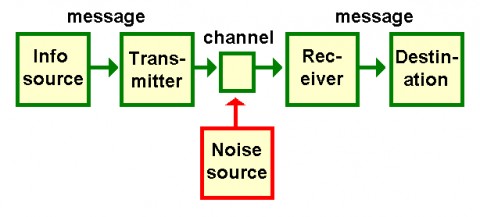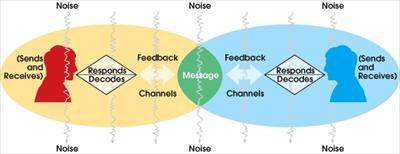The goal of communication is to convey meaning and information between people. With that in mind, modeling this process has taken two forms over the years as our knowledge and understanding of the field has changed, as well as how technology has changed.
Linear Model of Communication
The linear model of communication is an early communication model created by Shannon and Weaver which visualizes the transfer of information as an act being done to the receiver by the sender. Understanding several key terms is important in order to follow the model. These terms are:
Sender: the message creator.
Encoding: the process of putting thoughts into messages through the creation of content and symbols.
Decoding: the process of interpreting and assigning meaning to a message.
Message: the transmitted information.
Channel: the medium through which the message passes.
Receiver: the target of the sender and collector of the message.
Noise: those distractions which interfere with the transmission of the message.
[ad3]
This linear model is great for electronic media, such as radio and television, because of its one way nature, but it encounters several problems when looking at other channels.
As we all know, conversations with your friends and others are never one way, but rather they are back-and-forth, which is a problem with the linear model. A second problem is that encoding is typically done unconsciously. And finally, a third problem is that other factors like culture, environment, and relational history often come in play to affect the message.
Due to these problems, a better model was created: the transactional model of communication.
Transactional Model of Communication
The transactional model, unlike the linear, recognizes that communication is a simultaneous process and therefore switched both the terms “sender” and “receiver” to “communicator.”
It also adds “environment,” which embraces not only physical location, but also personal experiences and cultural backgrounds.
These changes can be seen in the model.
Another change you will notice in the transactional model is the overlap between each communicator. This recognizes similarities between each communicator’s environment. The model displays how communication becomes more difficult when communicator’s have less in common.
In addition, the transactional model recognizes how the type of channel can affect meaning. For example, the words “I love you” have a much different meaning if they are said through a billboard than through a voicemail.
In the linear model, noise is solely external noise; for example, loud music while trying to converse. The transactional model says that two other types of noise exist:
Physiological Noise: biological factors that interfere with communication (i.e. illness, fatigue, etc.)
Psychological Noise: the forces within that interfere with communication (i.e. an unwillingness to listen)
Overall, the transactional model realizes that it is not what we do to each other as senders and receivers, but it is what we do with each other as communicators.


Transactional is more democratic than linear which is autocratic.
Transactional is democratic
I wondered,communication not a merely subject
Thanks so much needed help understanding for my homework and now I DO!!!!!!!!!!!! frm Blondy xoxoxo
Thanks, now I can write my exam in peace
Could you put the references used in this article , especially for the picture of transactional process ? Thx
have do you reference this in assessement ??
Although both models are different, there are many good applications for both. The transactional model is however
More useful in interpersonal comunication. Even while in a linear type of situation, it is neccesarry to understand that the receiver is still going to be in transactional world.
I am exceptionally grateful for all the avenues of clarity, my professor, the book and the internet, wow I get triple for my trouble…………………………………………THANKS A BUNCH!
this is where i got my assignment from, btw i school im MUCST…
thanks admin!
where is the interactive model . THIS information is not enough to answer all of my question .
its useful information keep on posting info to us all….. thank you.
the linear one is autocratic and acts like an action model where one person sends a message and another just receives it, and the transactional model is more like democratic where communicators simultaneously sends and receive messages…thanx LOT FOR THE DIAGRAMS
Ya. it helps you to understand better…..
Its quite interesting to actually finding out the pros and cons attached rather associated with the two models of communication, becuse its from this knowledge were one is able to improve means nd ways of effective communication so I for one, I appreciate the lecture and article.
Added knowledge…… wow thanks!!!
great stuff! maybe your articles would help the researchers (like me) better if they have dates and names of the contributors of the article, so we can add them on to the bibliography part.
thanks!
Florence
Thank you for the explanation.It is bad for the linear model of communication for the receiver not to participate.We communicate to get the feedback as in transactional model of communication.
thank you.
Ca someone help me understand transactional communication and give me an example please?
Bitcoin?
I appreciate the insight. Can you help me further with real live examples of both linear and transactional models of communication.
that was fantastic! why not make it more explicable and interesting.
so meaning transactional communication is as same as non linear model
great stuff but where is the reference list